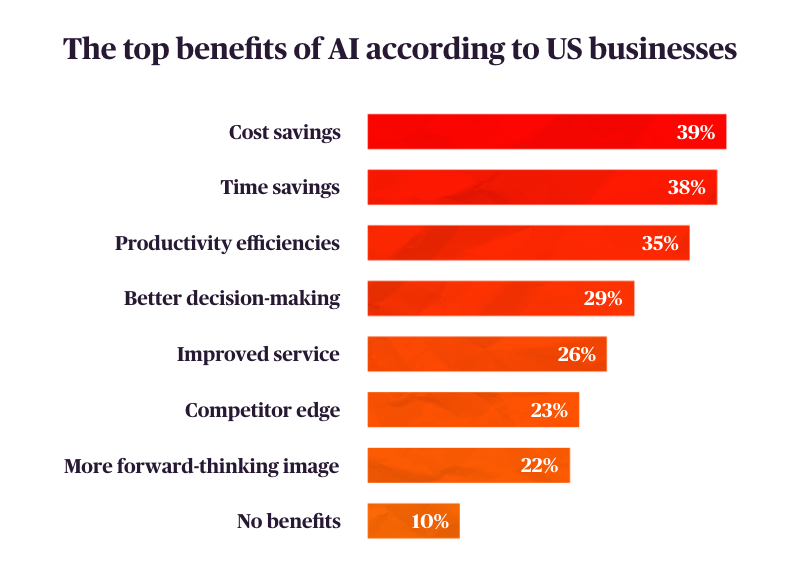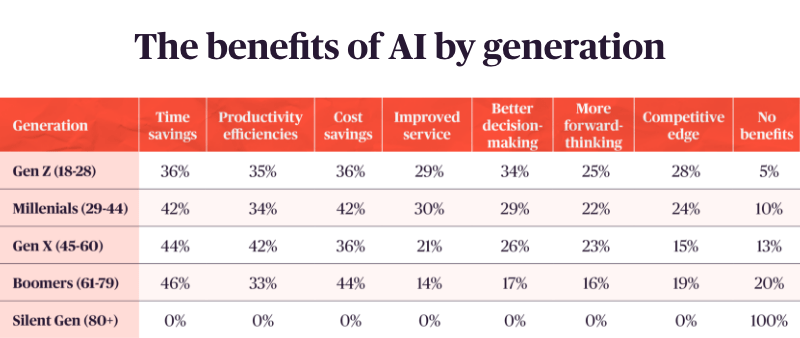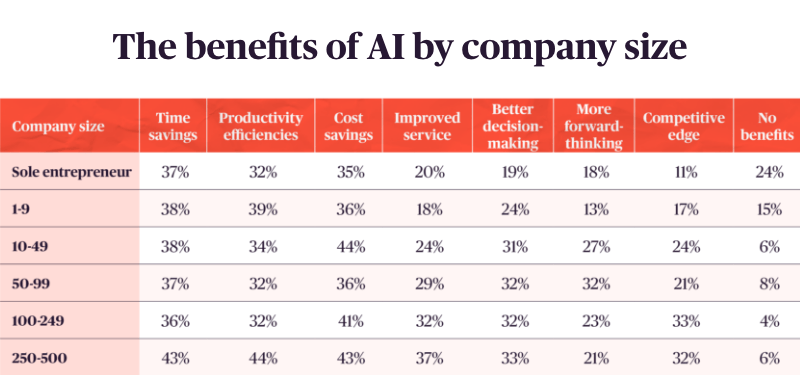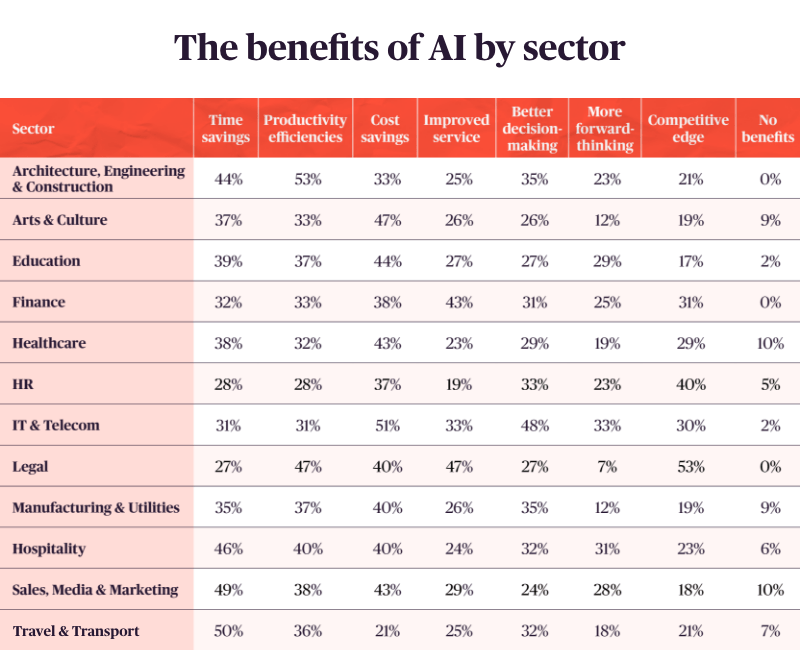In our first article, we looked at how U.S. businesses are adopting AI – and where they are on that journey. Now, we turn our focus to something just as important:
What do businesses believe AI is good for?
Perception matters. It doesn’t just influence whether a business adopts AI – it shapes how it’s used, how teams are trained, and how fast companies move from pilot testing to full integration.
To understand this better, we asked 750 U.S.-based business decision-makers a simple but telling question: “What, if anything, do you think are the main benefits of AI generally?”
Here’s what they said.
What are the top benefits of AI according to U.S. businesses?
According to our survey, the most widely recognized benefits were cost savings (39%), time savings (38%), and productivity efficiencies (35%).

Together, these form the practical core of AI’s value: helping businesses do more, faster and for less.
After that, a second tier of perceived value emerged:
- Better decision-making (29%)
- Improved service or outcomes (26%)
- Enhanced brand perception as forward-thinking (22%)
- Competitive advantage (23%)
Only 10% of respondents said they saw no benefits in AI at all, showing that while skepticism remains, it’s clearly in the minority.
How do different generations view the benefits of AI?
The Silent Generation (80+) appears completely disengaged from AI’s perceived value, with 0% recognition across all listed benefits, a striking 100% stating they see no benefit at all. This could reflect both a digital divide and a lack of direct exposure to AI-driven tools.

Baby Boomers (61–79) remain strong believers in time savings (46%) and cost savings (44%), though they’re less likely to attribute strategic gains to AI. Only 14% noted improved service, and just 17% recognized better decision-making.
Generation X (45–60) showed consistently solid recognition across practical benefits: cost savings (36%), time savings (44%), and productivity gains (42%). However, strategic benefits trailed slightly, with only 26% citing better decision-making and 21% noting improved service.
Millennials (29–44) topped the chart for cost savings (42%), and also showed strong belief in time savings (42%), improved service (30%), and competitive advantage (24%). They ranked slightly lower in productivity (34%) compared to Gen X.
Gen Z (18–28) led the way in seeing AI as a competitive advantage (28%) and a tool for a more forward-thinking brand (25%). But they were also the most skeptical, with 5% stating AI offers no benefits – the highest of any generation following from the Silent Generation. Their practical perceptions are mixed: cost savings and time savings both at 36%, and productivity at 35%.
How the size of a business affects perceived AI benefits
As with AI adoption, the size of a business plays a big role in how benefits are perceived – but it’s not just about scale. It’s about access, investment, and implementation.

At one end of the spectrum, solo entrepreneurs still showed noticeable skepticism, with 24% saying AI offers no particular benefit. But that wasn’t the whole story: 37% cited time savings and 35% cost savings, while 20% even saw potential for improved service.
Among micro and small businesses (1–49 employees), belief in time and cost savings began to take hold. Time savings reached 38% for both 1–9 and 10–49 employee groups, while cost savings hit 44% in the latter. Fewer saw AI as offering strategic value, but recognition of productivity and decision-making grew steadily.
In mid-sized businesses (50–249 employees), perception really started to shift. Around 30–40% reported productivity gains, while competitive edge and improved service ranged from 21–33%. Just 4% of 100–249 employee businesses said AI had no benefits.
Larger SMEs (250–500 employees) showed the most confidence overall: 43% cited both time and cost savings, 44% saw productivity efficiencies, and over a third highlighted strategic gains like better decision-making (33%) and improved service (37%).
Industry-by-industry: Which fields see the most value?
When we split the results by industry, a clear divide emerges – especially between data-heavy environments and those that rely more on human creativity and judgment.

Legal, IT & Telecom, and Healthcare reported the highest confidence in AI’s ability to save costs, with IT & Telecom leading the way at 51%. Productivity gains were strongest in Architecture (53%) and Legal (47%), while time savings topped out in Travel & Transport (50%) and Sales, Media & Marketing (49%).
More strategic benefits varied. HR and IT & Telecom were more likely to cite better decision-making (33% and 48%, respectively), while Legal led again in service improvements (47%). Finance stood out for improved service (43%) and competitive advantage (31%).
On the more cautious side, Arts & Culture and Manufacturing & Utilities had higher “no benefit” scores, up to 9%. These industries, along with Travel & Transport and Sales, Media & Marketing, also tended to report lower scores on productivity or service-related benefits.
This suggests that where workflows are more flexible or creative, AI is seen as less directly applicable, or harder to trust.
How AI benefits are viewed across U.S. regions
Location matters, not just in terms of access to tools, but in shaping how AI is discussed, embraced, and implemented within regional business communities.
States like Kentucky, New Hampshire, and Delaware stood out for high recognition of time savings, with 67% or more of businesses in those areas citing it as a key benefit.
Massachusetts reported strong belief in decision-making (62%) and competitive advantage (46%), suggesting a more strategic approach to AI adoption in innovation-focused hubs.
Arkansas and Idaho saw some of the highest scores for cost savings and productivity, with Arkansas reaching 83% on cost savings and Idaho showing 100% for productivity.
California businesses leaned more toward AI as a competitive and branding tool, with 42% saying it makes them look more forward-thinking and 42% citing competitive advantage.
In Florida and Georgia, adoption appeared balanced: high recognition of core benefits like time and cost savings, alongside a growing belief in service improvement and competitive edge.
At the other end of the scale, some states like Vermont, Montana, Hawaii, and Oregon reported little to no perceived benefit, with 100% of respondents in Vermont saying AI brings “no particular benefits.”
What’s clear is that regional exposure, peer adoption, and local industry makeup all play a role in shaping how businesses see AI. Where success stories are visible and tools feel relevant, belief grows. Where these are lacking, skepticism holds firm.
It’s a reminder that targeted regional outreach, through industry-specific examples, community partnerships, and practical education, could be essential to closing the perception gap and driving broader adoption.
What AI means for your business
What these results reveal is that perception matters just as much as capability.
Where businesses believe AI has something to offer, whether that’s faster workflows, better decisions, or a sharper competitive edge, they’re more likely to adopt it confidently and with purpose. AI-driven tools to support call handling, for example, can improve efficiency by automating customer interactions and allowing staff to focus on higher-value tasks.
And where skepticism lingers, especially among smaller firms, younger leaders, or specific industries, we need to make the case for AI in simple, relevant, and actionable terms.
Looking beyond the benefits of AI
In the coming weeks, Moneypenny will share more insights from our U.S. wide survey – including what businesses really think about AI, who they trust, the challenges they face, the risks they’re watching closely, and where they see the biggest opportunities ahead.
We’ll keep things clear and practical, so you get the insight you need to make confident, well-informed decisions about how AI can work for your business.
Interested in trying our AI Agent? See how our AI Voice Agent is already transforming client interactions.



















